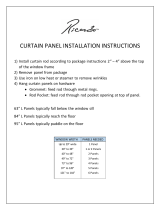1
Buy your curtains. You'll want to decide what style of curtain is right for you, if you
have not yet purchased your curtains and curtain rods. There are a number of styles,
each giving your room a different flavor and functioning in a slightly different way. Some
of your options include:
• Drapes are typically made from heavy material and are pleated, which requires a
traverse rod. To hang, you must place drapery pins in the pleat, and then hang them on
the rod. A cord allows you to pull the drapes open and closed.
• Panel curtains, eyelet curtains and tab top curtains are meant to hang from a plain
round rod. They may have a pocket along the top to push the rod through, or the rod
may be threaded through eyelets or tabs. Panel curtains may end at the top or bottom
of the windowsill, extend to the floor, or be even longer—a style known as puddling.
• Cafe curtains cover only the bottom half of a window, to let light into the room while
affording some privacy. They are popular on kitchen windows and are typically hung on
rods installed inside the window frame on tension rods.
• Door panels have pockets on the top and bottom and require 2 curtain rods, which you
install on a door or simply attach with magnets. Door panels are often used on french
doors and sidelights.
2
Decide where you want the bottom of your curtain to fall. When buying curtains,
keep in mind that their length should cover the entire window (unless they are cafe
curtains). If you buy tab top curtains, make sure the curtain length doesn't include the
length of the tabs.
• Floor length curtains end 1/2 inch (1.25 cm) from the floor unless you live in a humid
environment, in which case they should end 1 inch (2.5 cm) from the floor, because they
will stretch more on humid days. If you plan to puddle your curtains, you only need to
ensure you have plenty of material left over for the puddle.
• Curtains that hang below the sill should extend 4 inches (10 cm) below the sill, long
enough to cover the edge of the casing below the window.
• Sill-length curtains should skim the sill.








